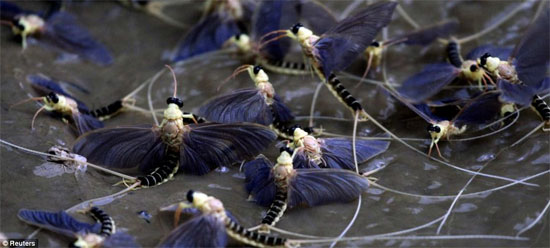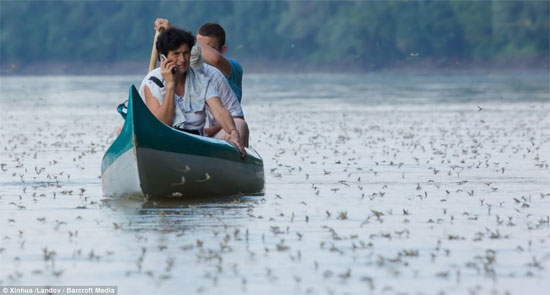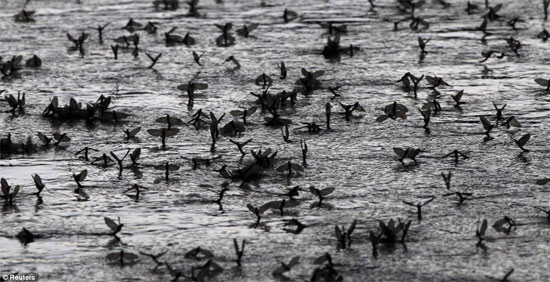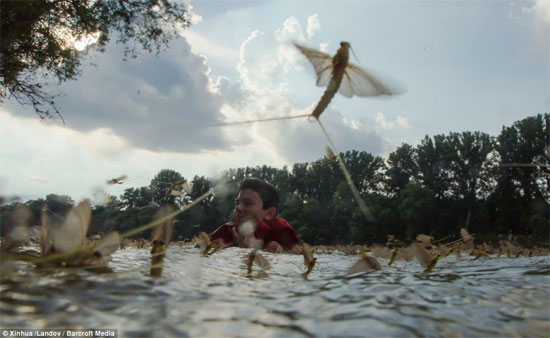Admire the ephemeral species 'reunion' on the river
In the late spring and early summer every year, millions of long-tailed ephemera floated to the surface of the Tisza River (Hungary) to find partners and mate before they died.
This amazing natural phenomenon makes the Tisza River near Tiszainoka one of Hungary's most attractive tourist destinations on the early summer. Tourists come here to see firsthand the millions of long-tailed ephemera (Palingenia longicauda) racing up the river to find their partners before dying.
The growth cycle of long-tailed phytoplankton begins with the larval stage. They grow in mud within 3 years before maturing into adult phytoplankton. Larvae live in small caves under mud in the riverbed, with about 400 caves / m 2 .
After developing to adulthood, the animals only have about 3 hours to mate and lay eggs before dying. With extremely short periods of time, male ephemeral people rushed to find them a suitable partner.

When a mate is found, the long-tailed fleets mate with each other on the water of a river longer than 135km in Tiszainoka. However, the fleeting 'love affair' is not romantic. A female ephemeral is often chased and mated with 20 males.
The plankton will fly from 1 to 3 km before laying eggs into the river. After that, the egg will sink to the bottom and hatch into larvae after about 45 days. European nymphs will then develop for 3 years before developing into adult phytoplankton.

Tourists rowing watching the fleeting river on the river Tisza near Tiszainoka, Hungary.

The plankton paired together to form a spectacular statue on the Tisza river.

A tourist swims among the fleeting forest.

Many tourists are not afraid to wet clothes, soak in Tisza river water to take photos of ephemeral in the breeding season.

Millions of long-tailed ephemera find partners and deliver streets on the Tisza river.

The tail of a ephemera turns water on the river.

The plankton in the hands of a tourist.
Ephemeroptera is a relatively ancient insect that has been around for over 300 million years. There are about 2,000 phytoplankton, very wide distribution. Their bodies are small and weak, small heads, large eyes, very weak diaphragm wings are very susceptible to fall, legs are very small, not used for crawling, just let them cling.
Adult fleets do not live a full day, usually only a few hours, because their mouths have degenerated, unable to eat or drink. The adult plankton is short-lived, but the larval plankton live for a long time. Adult mating is mating to lay eggs in the water, larvae must live 1-3 years in the water, then crawl to the shores to become adult fleets.
The larvae often dance after the sun sets into a small butterfly, which is now similar to the adult evanescent, but there is a translucent membrane covering the whole black body, dark wings, not flexible, cannot mate. After the young butterfly molting, there is a transparent, bright and transparent tail, an adult fleeting form. The adult stage does not eat or drink, just worry about mating and laying eggs. Laying off is dead. From the time the eggs hatch into larvae, it usually takes 20-24 times molting, up to 40 times. Phytoplankton larvae are delicious fish food.
- Fanciful world ephemeral
- River dolphin first appeared after nearly a century
- Confluent rivers are not suitable for color matching
- In 2013, twice admired the lunar eclipse
- 139 new species were discovered in the Mekong region
- Worms have 5 different faces
- Discovered an additional window window on Reunion island
- Volcanic activity in Reunion Island increased sharply
- Video: Waterfalls flow back up into the sky on Reunion Island
- Admire the rare species of the Mekong
- Dams on the Mekong River threaten large fish
- Discover a small continent hidden under lava in the islands of Reunion and Mauritius
 Why do potatoes have eyes?
Why do potatoes have eyes? 'Tragedy' the world's largest carnivorous life: Death becomes ... public toilet
'Tragedy' the world's largest carnivorous life: Death becomes ... public toilet Tomatoes were once considered 'poisonous' for 200 years
Tomatoes were once considered 'poisonous' for 200 years Detecting microscopic parasites on human face
Detecting microscopic parasites on human face